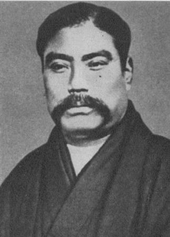Iwasaki Yatarō
| Iwasaki Yatarō | |
|---|---|
 | |
| Born |
岩崎 弥太郎 January 9, 1835 Aki, Tosa Province, Japan |
| Died |
February 7, 1885 (aged 50) Taitō, Tokyo, Japan |
| Nationality | Japanese |
| Occupation | Industrialist |
| Known for | Founder of Mitsubishi |
Iwasaki Yatarō (岩崎 弥太郎, January 9, 1835 – February 7, 1885) was a Japanese financier and shipping industrialist, and the founder of Mitsubishi.
Early life
Iwasaki was born in a provincial farming family in Aki, Tosa province (now Kōchi Prefecture), the great-grandson of a man who had sold his family's samurai status in obligation of debts. Iwasaki began his career as an employee of the Tosa clan. The clan had business interests in many parts of Japan.
Iwasaki left for Edo (now Tokyo) aged nineteen for his education. He interrupted his studies a year later when his father was seriously injured in a dispute with the village headman. When the local magistrate refused to hear his case, Iwasaki accused him of corruption. Iwasaki was sent to prison for seven months. After his release, Iwasaki was without a job for a time before finding work as a teacher.
Returning to Edo, he socialised with political activists and studied under the reformist Yoshida Toyo, who influenced him with ideas of opening and developing the then-closed nation through industry and foreign trade. Through Yoshida, he found work as a clerk for the Tosa government, and bought back his family's samurai status. He was promoted to the top position at the Tosa clan's trading office in Nagasaki, responsible for trading camphor oil and paper to buy ships, weapons, and ammunition.
Following the Meiji Restoration in 1868, which forced the disbandment of the shogunate's business interests, Iwasaki travelled to Osaka and leased the trading rights for the Tosa clan's Tsukumo Trading Company. The company changed its name to Mitsubishi in 1873.
Mitsubishi
Yatarō became president of Mitsubishi in March 1870. The name Mitsubishi is a compound of mitsu ("three") and hishi (literally, "water chestnut", often used in Japanese to denote a diamond or rhombus). Its emblem was a combination of the Iwasaki family crest and the oak-leaf crest of the Yamanouchi family, who were leaders of the Tosa clan, which controlled the part of Shikoku where Yatarō was born.
In 1874-5, Yataro was contracted by the Japanese government to transport Japanese soldiers and war materials. The Japanese government purchased a number of ships for the Japanese Expedition of 1874 to Taiwan against Paiwan Aborigines in southeast Taiwan and these ships were later given to Mitsubishi after the expedition was finished in 1875. This created strong links between Mitsubishi and the Japanese government that ensured the new company's success. In return, Mitsubishi supported the new Japanese government and transported troops who defeated the Satsuma Rebellion in 1877. Thus the success of Mitsubishi became intertwined with the rise of the modern Japanese state.
Subsequently he invested in mining, ship repair, and finance. In 1884 he took a lease on the Nagasaki Shipyard, which allowed the company to undertake shipbuilding on a large scale, and renamed it Nagasaki Shipyard & Machinery Works.
Iwasaki Yatarō often gave dinners for dignitaries, spending a huge amount of money on these occasions, but he also made many friends who later helped him by doing favors.
Yatarō died of stomach cancer aged 50, and was succeeded as the head of the family business first by his brother, and later his son, Hisaya.
See also
| Wikimedia Commons has media related to Iwasaki Yataro. |
References
- "The Man Who Started It All", Mitsubishi.com
- "The origin of MHI can be traced all the way back to 1884", MHI-ir.jp
- Woy, Jean L. (2005). The Human Record: Sources of Global History. Boston: Houghton Mifflin Company. pp. 353–356. ISBN 0-618-04247-4.
- Yamamura, Kozo (Summer 1967). "The Founding of Mitsubishi: A Case Study in Japanese Business History.". The Business History Review 41 (2): 141–160. JSTOR 3112564.
- Weston, Mark (July 1999). Giants of Japan: the Lives of Japan's Greatest Men and Women. New York: Kodansha America. ISBN 1-56836-286-2.
- "The Mitsubishi Mark", Mitsubishi.com